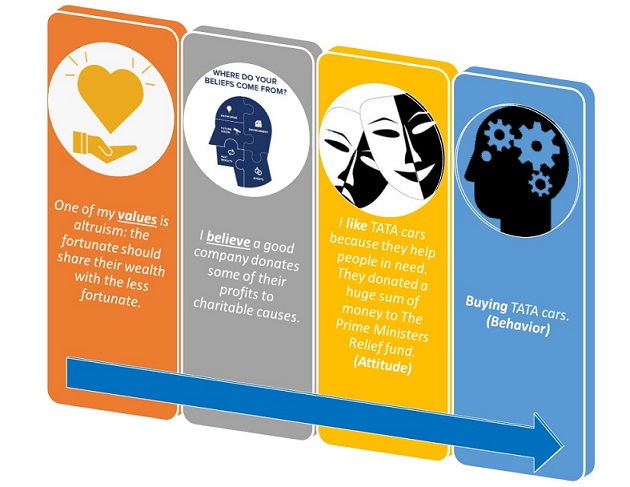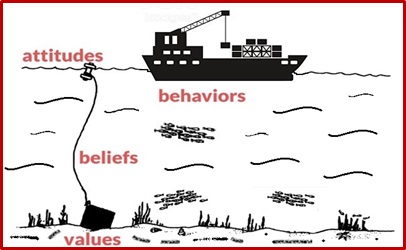We are a nation of cricket lovers. The feature that we hit upon straightaway when visiting a cricket stadium for the first time is the grass. Pruned to perfection, it exhibits stripes, diamonds, a checkerboard, or even arches.
Over the years I have gathered many theories about how they’re created: the grass is colored, has different lengths, and so on., but the real reason is a lot naiver. It’s the direction of the blades that tints the grass in various shades. When the sun hits an upright blade, its whole frame reflects the light – rendering it brighter than a blade that points directly towards the sun. Most professionals create the patterns by mowing in different directions. But the astute among them have another trick up their sleeve: they use a simple roller behind their mower to direct the blades with even more force.
And the same way the mowing and rolling directs the grass, our values and beliefs direct our behavior as humans.
What influences our behavior?
On the surface, most of our human behaviors don’t seem rational. But if you follow these impulses down to their roots, everything starts to make sense.

It’s called the Value-Behavior Chain. Our Values influence our beliefs, which determine our attitudes that guide our behavior. That means if a business wants to influence its customers behavior, it must change their attitudes, beliefs or values first.
Values
Values are a measure of worth we attach to something. We can value something very little– meaning basically don’t care. Or we can value someone a lot– going out of our way to do something for that person. Going even further, values are often guide us between what’s good and what’s bad. Universal values are for example happiness, love, freedom, respect, equality and justice. But they can also be as specific as this:
- One of my values is altruism: the fortunate should share their wealth with the less fortunate.
Beliefs
A belief is a feeling that something is true. As a whole, our beliefs represent all the bits of information we collect about people, events and things in life. They don’t necessarily have to be rational or based on facts. They can even be false beliefs and we still cling on to them. They grow stronger the longer we keep them and the more we keep repeating them to ourselves or others. Following our example chain, this could be a belief that’s based on the value above:
- I believe a good company donates some of their profits to charitable causes.
Attitudes
Our attitudes are based on our values (good and bad) and our beliefs (what we know). And they express our relationship towards the world around us. Based on what we value and believe, we like something or dislike it. Or we are ambivalent. An example attitude in our chain might be:
- I like TATA cars because they help people in need. They donated a huge sum of money to The Prime Ministers Relief fund.
Behavior
Our behavior is simply what we do and say–our words and actions. Based on the attitude above, the chain would be concluded through the following behavior:
- Buying TATA Cars.

How are they associated?
Your attitudes are like buoys. They are attached to a chain (your beliefs). And the chain is anchored to the ground (your values). Like the ground, your values will rarely change. Depending on the tide–the circumstances in your life-the buoy will go up and down.

Meaning your attitudes will adapt to what’s happening to you. But they will always depend on your beliefs, as these can be stretched only so far before they break. The only missing piece in the picture is our behavior. Not hard to guess, they are the ships which are guided by the buoys.
As soon as you dive below the surface, people are a lot more rational than they often seem. In fact, their behavior becomes quite clear when you take their motives into account:
- their values: what they find good and not good
- their beliefs: what they know
- Their attitudes: how the relate to their surroundings
And once you know their motives, getting them along becomes as easy as creating a perfectly shaped checkerboard on a cricket field.
Content Curated By: Dr Shoury Kuttappa


2 replies on “THE VALUES AND BELIEFS CHAIN”
Nice write up Shoury. I will send you a note on what I understood as the difference and relation between beliefs and values.
I guess it will help.
LikeLike
Nice write up Shoury. I will send you a note in what I understood as the difference and relation between beliefs and values.
I guess it will help.
LikeLike